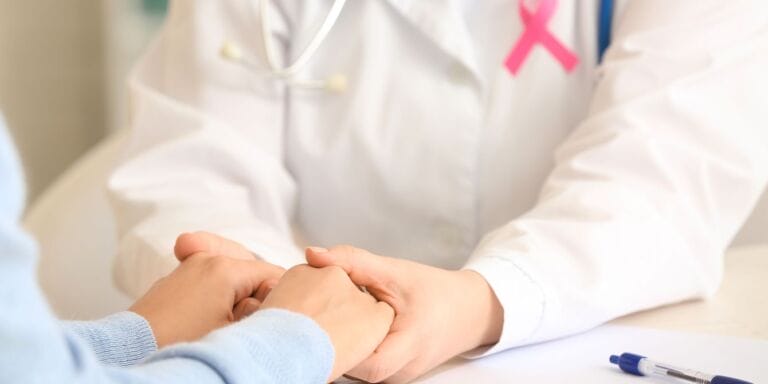Can you get pregnant with endometriosis? A fertility expert explains

Olena Yakobchuk/Shutterstock
Getting pregnant with endometriosis may be challenging, but it’s not impossible.
Table of Contents
More than 10 million people in the United States have endometriosis,1Soliman AM, Surrey E, Bonafede M, et al. Real-world evaluation of direct and indirect economic burden among endometriosis patients in the United States. Adv Ther 35, 408–423 (2018). doi:10.1007/s12325-018-0667-3 though the condition often goes undiagnosed (or is misdiagnosed). Many of those who struggle with this painful disease will try to conceive at some point, which can be a difficult journey. The good news? It is possible to get pregnant with endometriosis. Here’s what you need to know about endometriosis and fertility.
Endometriosis is more common than you think
According to the World Health Organization, some 1 in 10 people born with a uterus are diagnosed with endometriosis each year around the world. Endometriosis most commonly affects those between 30 and 40 years of age,2Soliman AM, Surrey E, Bonafede M, et al. Real-world evaluation of direct and indirect economic burden among endometriosis patients in the United States. Adv Ther 35, 408–423 (2018). doi:10.1007/s12325-018-0667-3 and up to half of those diagnosed with the condition have trouble getting pregnant.
Even though this disease can cause pain and make conceiving more difficult, most people with endometriosis are still able to have children. However, receiving proper treatment and support is essential, as untreated endometriosis can lead to additional fertility struggles, pain and, in some cases, surgery.
Related: A new gene identified for endometriosis may lead to a better way to treat it
What exactly is endometriosis?
Endometriosis is an inflammatory, estrogen-dependent condition in which endometrial tissue grows outside the uterus. The breakdown of this tissue and the inflammation response each month can cause scar tissue to form, and even make organs to “stick” together, leading to chronic pelvic pain in reproductive-aged women or people born with a uterus, as well as these other common symptoms.
Common symptoms of endometriosis
- Pain before, during, and after a menstrual period
- A family history of endometriosis or pelvic pain
- Frequent or persistent sharp and/or dull pelvic pain
- Pain during intercourse
- Pain during bowel movements or urination
- Bladder pain
- Generalized abdominal discomfort
Not everyone with endometriosis has pain or symptoms, though. It’s only once they try to conceive that doctors may diagnose the disease by ultrasound, a pelvic exam, abdominal surgery or after a trial of medication.
Related: Yes, you *can* get pregnant with PCOS. A fertility expert shares how
The connection between endometriosis & infertility
Around 4 in 10 women struggling to conceive have endometriosis. The inflammation associated with the disease can negatively affect fertilization, damage the sperm or egg or obstruct their journey through the fallopian tubes and uterus. In more severe cases, the fallopian tubes may even be completely blocked by scar tissue.
If you end up needing the help of a fertility specialist to conceive, your doctor may first look into surgery to remove scar tissue or large endometriotic cysts, allowing your ovaries and fallopian tubes to work better. Other treatments like ovulation induction or intrauterine insemination (IUI) treatment may help you get pregnant, as well. In the event of tubal damage or a blocked fallopian tube, in vitro fertilization (IVF) may help you bypass the “ovary-fallopian tube” connection to successfully become pregnant.
Related: Amy Schumer says she ‘finally’ feels good months after endometriosis surgery
Navigating intimacy, sex and endometriosis
In addition to fertility challenges, those with endometriosis often struggle with pain during intercourse,3Norinho P, Martins MM, Ferreira H. A systematic review on the effects of endometriosis on sexuality and couple’s relationship. Facts Views Vis Obgyn. 2020;12(3):197-205. Published 2020 Oct 8. which can become problematic when trying to conceive. In this case, open communication and transparency with your partner is key. Share how you feel both physically and emotionally, and seek out extra support when needed—especially because endometriosis is often associated with a higher level of anxiety and depression.4Warzecha D, Szymusik I, Wielgos M, Pietrzak B. The Impact of Endometriosis on the Quality of Life and the Incidence of Depression-A Cohort Study. Int J Environ Res Public Health. 2020;17(10):3641. Published 2020 May 21. doi:10.3390/ijerph17103641 This makes surrounding yourself with the right support in the form of therapy (both individual and with your partner), empathetic friends and family, and prioritizing self-care and exercise even more important.
The bottom line? Those with endometriosis can (and do) have healthy pregnancies and relationships. But the path to get there is not always linear. If you’re struggling to conceive or experiencing symptoms of endometriosis, do not hesitate to seek out medical assistance. With the right support, you can treat your endometriosis and grow your family.
About the author
Mark Leondires, M.D. is the founder and medical director at Illume Fertility. Dr. Leondires is also the founder of Gay Parents To Be, a leading family-building resource for the LGBTQ+ community. He is board certified in obstetrics and gynecology, as well as reproductive endocrinology and infertility.
Sources
1. & 2. Soliman AM, Surrey E, Bonafede M, et al. Real-world evaluation of direct and indirect economic burden among endometriosis patients in the United States. Adv Ther 35, 408–423 (2018). doi:10.1007/s12325-018-0667-3
3. Norinho P, Martins MM, Ferreira H. A systematic review on the effects of endometriosis on sexuality and couple’s relationship. Facts Views Vis Obgyn. 2020;12(3):197-205. Published 2020 Oct 8.
4. Warzecha D, Szymusik I, Wielgos M, Pietrzak B. The Impact of Endometriosis on the Quality of Life and the Incidence of Depression-A Cohort Study. Int J Environ Res Public Health. 2020;17(10):3641. Published 2020 May 21. doi:10.3390/ijerph17103641
Source(s)
- 1Soliman AM, Surrey E, Bonafede M, et al. Real-world evaluation of direct and indirect economic burden among endometriosis patients in the United States. Adv Ther 35, 408–423 (2018). doi:10.1007/s12325-018-0667-3
- 2Soliman AM, Surrey E, Bonafede M, et al. Real-world evaluation of direct and indirect economic burden among endometriosis patients in the United States. Adv Ther 35, 408–423 (2018). doi:10.1007/s12325-018-0667-3
- 3Norinho P, Martins MM, Ferreira H. A systematic review on the effects of endometriosis on sexuality and couple’s relationship. Facts Views Vis Obgyn. 2020;12(3):197-205. Published 2020 Oct 8.
- 4Warzecha D, Szymusik I, Wielgos M, Pietrzak B. The Impact of Endometriosis on the Quality of Life and the Incidence of Depression-A Cohort Study. Int J Environ Res Public Health. 2020;17(10):3641. Published 2020 May 21. doi:10.3390/ijerph17103641


































